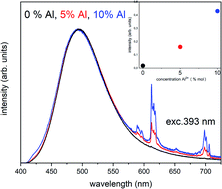Influence of Al3+ co-doping on the spectral properties of europium doped Ca9Y(PO4)7
Abstract
A series of luminescent materials based on a calcium yttrium phosphate matrix doped with europium and different concentrations of aluminum ions (0, 5, 10% of mole) was synthesized using the Pechini method. A two-step strategy of synthesis was applied. Phase composition analysis and spectroscopic measurements were performed to characterize the obtained phosphors. The XRD patterns show that in all cases the obtained materials consist of a pure phase of Ca9Y(PO4)7. Emission spectra of the materials obtained after the first step of the synthesis consist of narrow bands attributed to 5D0–7FJ transitions in Eu3+ ions. Independently of the aluminum concentration, europium ions are incorporated into at least two different cationic sites. Considering the asymmetric ratio (R), the sites are characterized by the presence/absence of inversion symmetry. The emission intensity of Eu3+ introduced into the more symmetric site decreases with increasing aluminum concentration. The emission spectra of the materials after the reduction process are characterized by intensive broad bands located at 420 and 488 nm attributed to the d–f transitions in Eu2+; however, the line shape of the spectra depends on the aluminum concentration. Moreover, incorporation of aluminum ions causes the stabilization of the Eu3+ ions under a reductive atmosphere.



 Please wait while we load your content...
Please wait while we load your content...